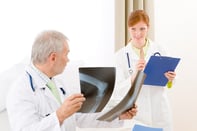Uncovering and Highlighting a Niche to Stand Out in the Medical Education Space

Beyond the rankings lists and brand reputations, it can be difficult to differentiate medical schools in today’s highly competitive medical education marketplace. What’s more, as increasing numbers of institutions introduce medical education programs, it’s more important than ever for leaders to seriously consider the elements necessary to help them stand out. In this interview, Sonia Oyola reflects on the process of launching a culinary medicine program at the University of Chicago, in partnership with Kendall College, and shares her thoughts on the impact this program has on the University of Chicago’s position in the medical education space.
The EvoLLLution (Evo): What was the impetus behind helping to launch the culinary medicine program in partnership with Kendall College?
Sonia Oyola (SO): In the Spring of 2013, the Department of Family Medicine was approached by a public health expert who had recently helped develop New York City’s campaign for better nutrition and ways to address obesity. She approached our department because of our focus on prevention, population health promotion, patient education and community medicine. Having become aware of Dr. Tim Harlan and Chef Leah Sarris’ CM (culinary medicine) curriculum at Tulane University and our faculty’s specific interest in the areas of nutrition and food as medicine, a connection was made with Kendall College, a well recognized and respected culinary institute who would support the initiative.
The initial steps for our collaboration included many meetings to understand each other’s mission and intention for making this curriculum available. We were fortunate that the former dean of Kendall College and chef-instructor for the program is a registered dietician who had counseled patients for many years at a dialysis clinic. Because of this rich background in healthcare and advising patients with fairly limited diets, she would be the ideal instructor. The other key element to launching the program was student interest. Many students would approach us asking how they can augment their nutrition knowledge. Without student interest, very few of these types of innovations would come to fruition.
Evo: What factors differentiate this program from other courses and programs run by the Pritzker School?
SO: The primary difference is the practical nature of culinary medicine. In our program, medical students are being taught how to translate nutrition science into delicious, affordable and accessible dishes that will benefit their future patients. To explain further, only approximately 33 percent of medical schools have separate nutrition courses and, of those, many of the classes are embedded within biochemistry. Students therefore learn the chemical structure and physiological function of macronutrients and micronutrients, like fat and vitamin D for example, but not how to advise a patient on how to incorporate these nutrients into the diet. An important point to emphasize is that both types of information are invaluable to a future physician.
Our program values the informational background a course in biochemistry will provide. We are simply taking that knowledge one step further by discussing the resources where these nutrients exist, how access to cooking creates a challenge for many of us and how we can motivate patients to take small steps toward creating a diet that benefits their current health status. The other key element that sets this program aside is the multi-disciplinary approach of family physicians teaching the program alongside a registered dietician and chef.
Evo: How do programs like this help a medical school really differentiate itself from other providers of medical education?
SO: A medical school that supports programs like culinary medicine will help ensure that future physicians have the skills, tools and resources to both manage a population burdened with such conditions as diabetes, hypertension and obesity and prevent the aforementioned conditions. This approach would lean away from a purely reductionists view to one that is more comprehensive. While multidisciplinary teaching teams are on the rise, it is still rare to find departments and disciplines like Family Medicine and Dietetics integrating their knowledge and co-teaching.
These approaches and initiatives set the Department of Family Medicine and Pritzker School of Medicine apart from the typical manner in which students are trained.
Evo: What were some of the most significant challenges to getting the program approved, and how did you overcome those obstacles?
SO: Three of the most significant challenges when adopting a new curricular initiative in a medical school are:
- Finding time in the students’ already busy schedule where the initiative can be taught
- Demonstrating value
- Finding the resources necessary to launch the initiative
We were lucky to have had student support from the very start but we then had to work with the school to assess where this type information fits best. Is it in the first year when students are just learning anatomy, the second year when they’re in the world of pharmacology or it is during their third and fourth clinical years? Would a student who will have little access to patients, aside from volunteering at free clinics, find this information useful or should we make sure fourth years, about to start residencies in their field, get exposed to this information?
In the end, we decided that our pilot would be open to all interested and who could reasonably add it into their schedules. We also decided to shorten the program by half, only offering four out of the eight modules created by the team at Tulane.
Finding the resources to support these classes was the next step, which ultimately came from the Women’s Board of the University of Chicago. This is group of women from various professional backgrounds and fields who uniformly saw the importance of this type of instruction. They granted us the entire budget amount requested and were extremely supportive throughout the process.
Another resource challenge is finding faculty willing to teach a relatively new and ever-changing topic like nutrition through this innovative approach, culinary medicine. Many medical schools are unfortunately lacking faculty expertise of this topic but as mentioned, our department had faculty both interested and trained in nutrition beyond the average physician. The Department of Family Medicine sees value in the CM program which encompasses self-care, eating in community and reflecting on the challenges of eating nutritiously. Currently, a single module is being introduced to students as part of the required coursework during their Family Medicine 4-week Clerkship.
Evo: How do you see the culinary medicine program evolving over the coming years?
SO: We hope that some element of the program will be introduced at various stages throughout the four years of medical school. Ideally, the entire eight-week program would be available as an elective to fourth-year students. We are also hoping to expand the training to our faculty, residents and physicians out in practice. Our patients and colleagues are seeking this information avidly and we hope to help fill the gaps in knowledge, encourage the application of this information into our own lives in order to address the high rates of burnout that exists at all levels of medical school training and beyond.
It is an exciting time and we are thrilled to be one of the educational leaders within a healthcare movement that is focused on prevention and wellness!
Author Perspective: Administrator



